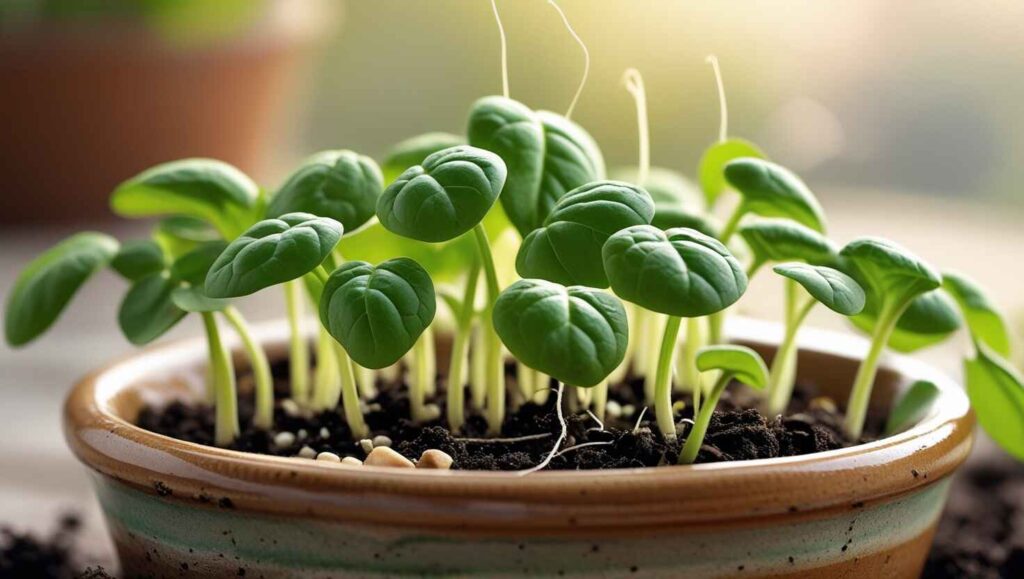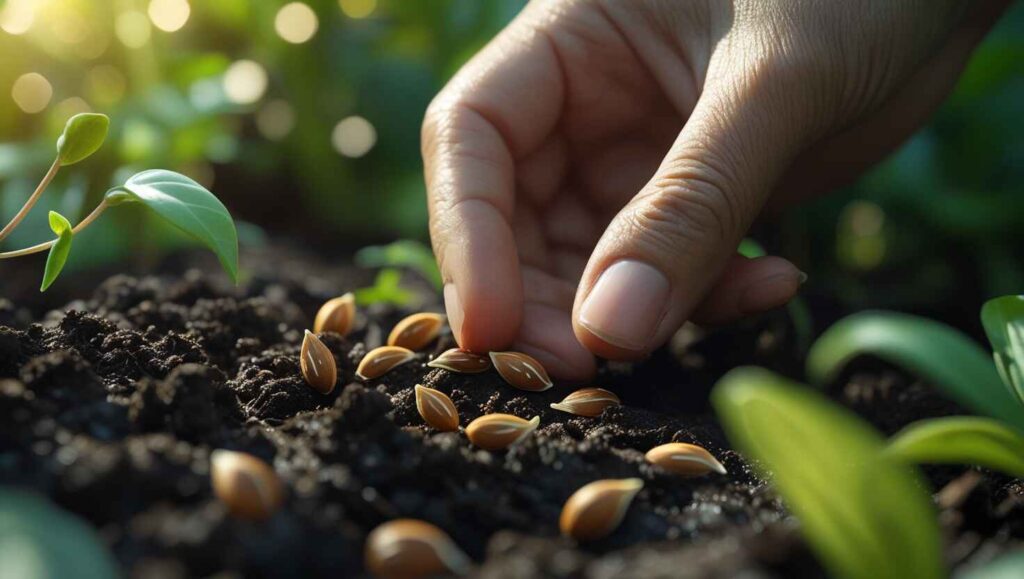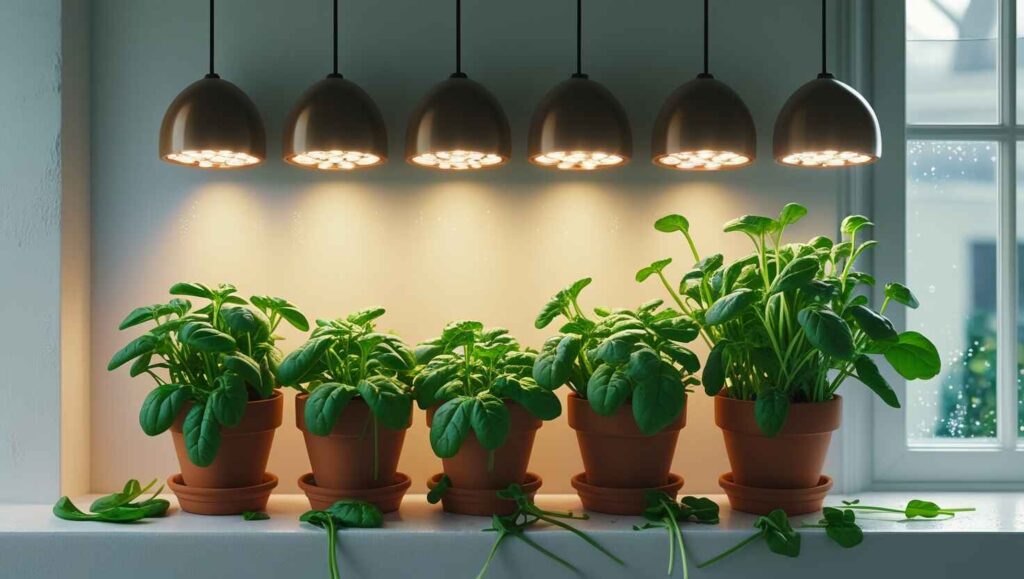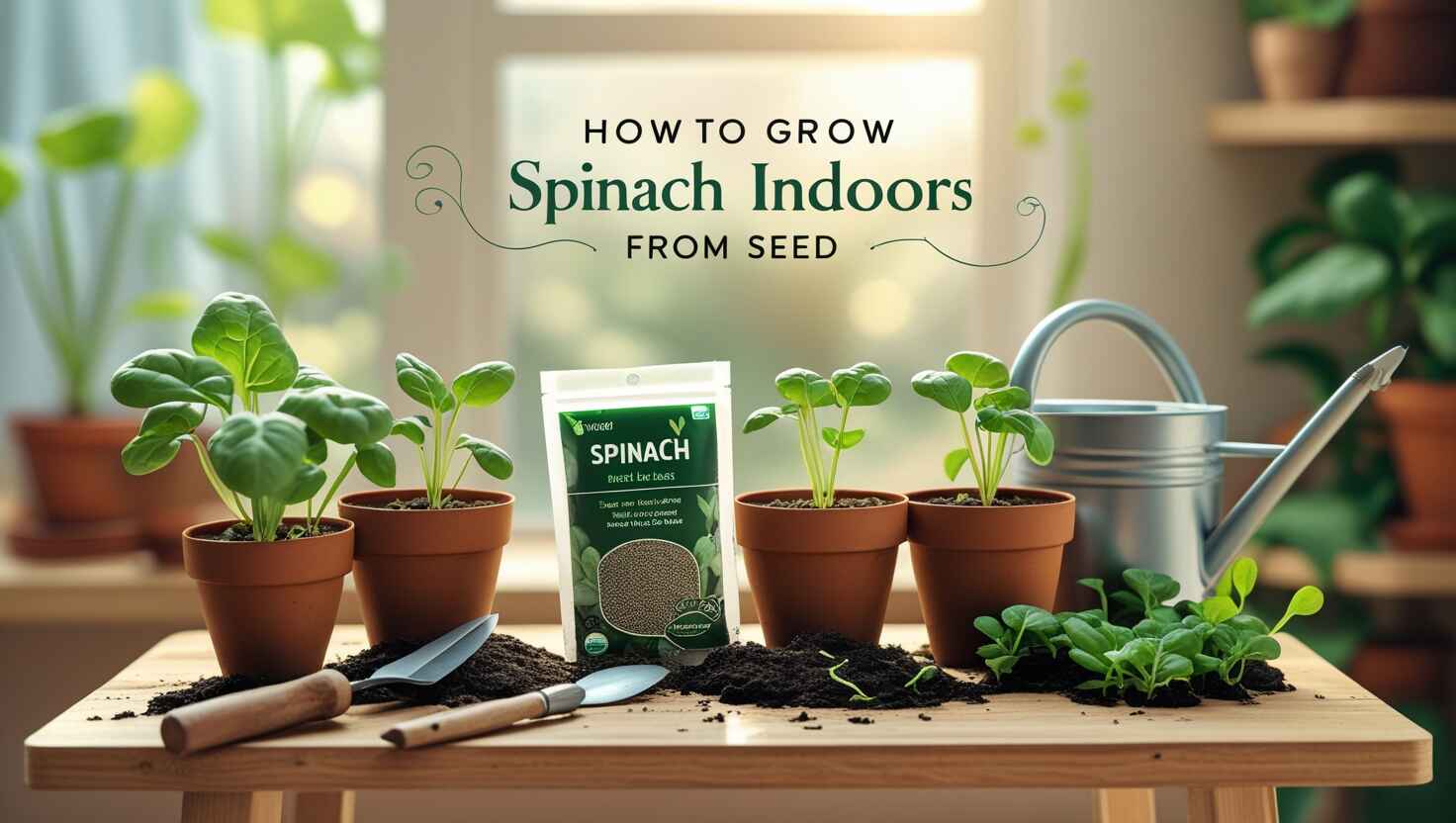Growing spinach indoors is the best way to have fresh, healthy greens all year round. This leafy green is good for you and versatile in cooking. Whether you have no outdoor space or want to grow spinach in winter, an indoor garden is the answer. Spinach is easy to grow so perfect for beginners.
Why Grow Spinach Indoors?
- Fresh All Year: Indoor spinach means fresh, chemical free greens no matter the season.
- Space Saving: Even a small windowsill or countertop can fit a spinach pot.
- Controlled Environment: Indoor gardening means no pests and no unpredictable weather.
Choosing the Right Spinach Variety
Some spinach varieties are better than others for indoor growing. Choose these:
- Baby Spinach: Tender leaves and fast growing.
- Savoy Spinach: Crinkled leaves and full of flavor.
- Smooth-Leaf Spinach: Easier to clean, perfect for indoor growing.
Supplies Needed to Grow Spinach Indoors

- Containers: Pots with drainage holes; shallow pots are fine as spinach has a shallow root system.
- Potting Mix: A nutrient rich, well draining potting mix.
- Seeds: Buy quality spinach seeds from a reputable supplier.
- Grow Lights: If natural sunlight is limited, get LED grow lights.
- Watering Can: For controlled watering to avoid overwatering.
Before You Plant Spinach Seeds
1. Choose the Right Spot
Pick a spot with lots of sunlight. A south facing window is best but grow lights can supplement low light areas.
2. Prepare the Soil
Make sure the potting mix is light, well draining and has organic compost. pH 6.0–7.5 for best growth.
How to Plant Spinach Seeds

- Fill the Pot: Fill the pot with potting mix, leaving an inch at the top.
- Plant the Seeds: Sow the seeds ½ inch deep and 2–4 inches apart.
- Water the Soil: Water the soil lightly to keep it moist but not wet.
- Cover the Seeds: Press the soil gently over the seeds to secure them in place.
- Give Light: Place the pot in a spot that gets 6–8 hours of sunlight or use grow lights for 12–14 hours.
How to Care for Spinach Indoors

1. Watering
Spinach likes consistent moisture. Check the soil daily and water when the top inch is dry. Overwatering can cause root rot so make sure there’s good drainage.
2. Fertilizing Spinach
Use a balanced, water soluble fertilizer every 2–3 weeks to encourage healthy growth. Avoid too much nitrogen as it can make the leaves bitter.
3. Thin the Plants
Once the seedlings are 2 inches tall, thin them by snipping the weaker ones, leaving the strongest ones 4–6 inches apart.
4. Pests
Indoor spinach is less likely to get pests but keep an eye out for aphids or spider mites. Use neem oil or insecticidal soap if necessary.
Indoor Spinach
- When to Harvest: Harvest when leaves are 3–4 inches long, about 4–6 weeks after sowing.
- How to Harvest: Snip off outer leaves with scissors, leaving inner ones to continue growing for multiple harvests.
Common Issues and Solutions
1. Yellow Leaves: Overwatering or nutrient deficiency. Adjust water and add fertilizer if needed.
2. Leggy: Not enough light. Make sure to get enough sunlight or use grow lights.
3. Slow Growth: Cold temperatures and poor soil can cause slow growth. Make sure to keep optimal conditions.
Why Grow Spinach Indoors
- Nutritional Value: Iron, vitamins A, C, K and antioxidants.
- Convenience: Fresh greens whenever you need them, no more grocery trips.
- Eco-Friendly: Indoor gardening reduces food waste and packaging.

Indoor Spinach FAQs
Q: Can spinach grow without sunlight?
A: Spinach can grow under LED grow lights, perfect for low light indoor spaces.
Q: How often to water?
A: Water when the top inch of soil is dry.
Q: Can I regrow?
A: Yes, it’s a cut-and-come-again. Harvest the outer leaves and it will continue to grow.
3. What is the ideal temperature for growing spinach indoors?
Spinach grows best at temperatures between 50–75°F (10–24°C). Avoid exposing plants to excessive heat as it can cause bolting.
4. How long does it take for spinach to grow indoors?
Spinach takes about 40–50 days to mature indoors, depending on the variety. Baby spinach leaves can be harvested within 3–4 weeks.
5. Can I reuse the soil for the next spinach planting?
Yes, but it’s recommended to refresh the soil with compost or organic fertilizer to replenish nutrients before replanting.
6. What type of containers are best for growing spinach indoors?
Choose containers that are at least 6–8 inches deep with good drainage holes. Materials like ceramic, plastic, or terracotta are ideal.
7. How do I prevent pests from damaging my indoor spinach plants?
Keep pests away by using neem oil spray or insecticidal soap. Inspect plants regularly for signs of aphids or spider mites.
8. Can I grow spinach hydroponically indoors?
Yes, spinach can thrive in a hydroponic system. It requires nutrient-rich water, proper lighting, and regular monitoring of pH levels.
9. How do I know when to harvest spinach?
Harvest spinach when the leaves are about 4–6 inches long. Pick outer leaves first, allowing the plant to continue growing.
10. What spinach varieties are best for indoor growing?
Varieties like Bloomsdale, Baby’s Leaf, and Space Hybrid are ideal for indoor growing due to their compact size and adaptability.
11. Can spinach regrow after harvesting
Yes, spinach is a cut-and-come-again plant. Harvest leaves carefully, and the plant will produce new growth for continuous harvest.
12. Do spinach plants need fertilizer indoors?
Yes, fertilize spinach every two weeks with a balanced, water-soluble fertilizer to ensure healthy growth and high yields.

